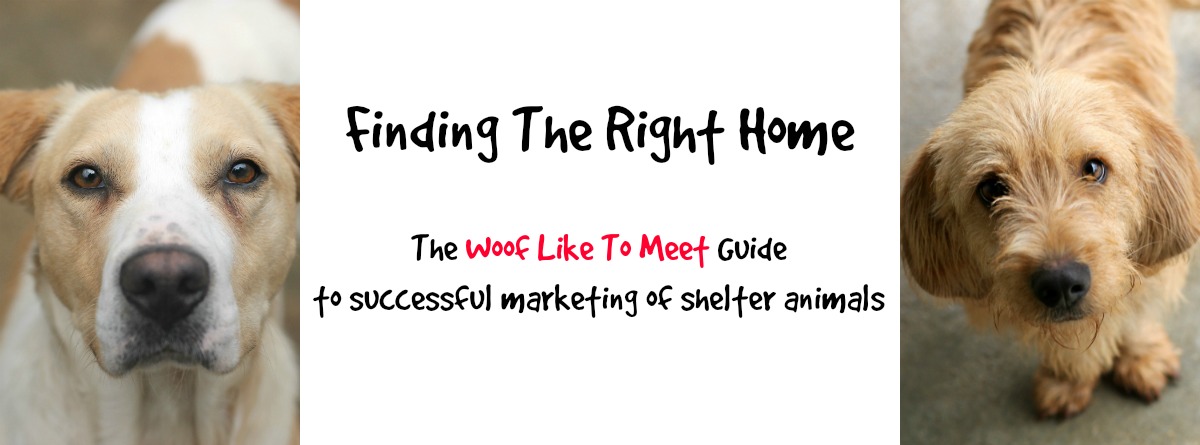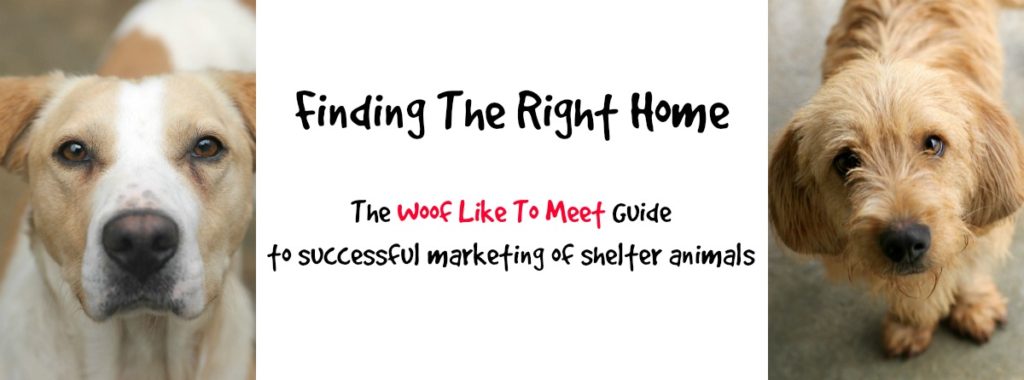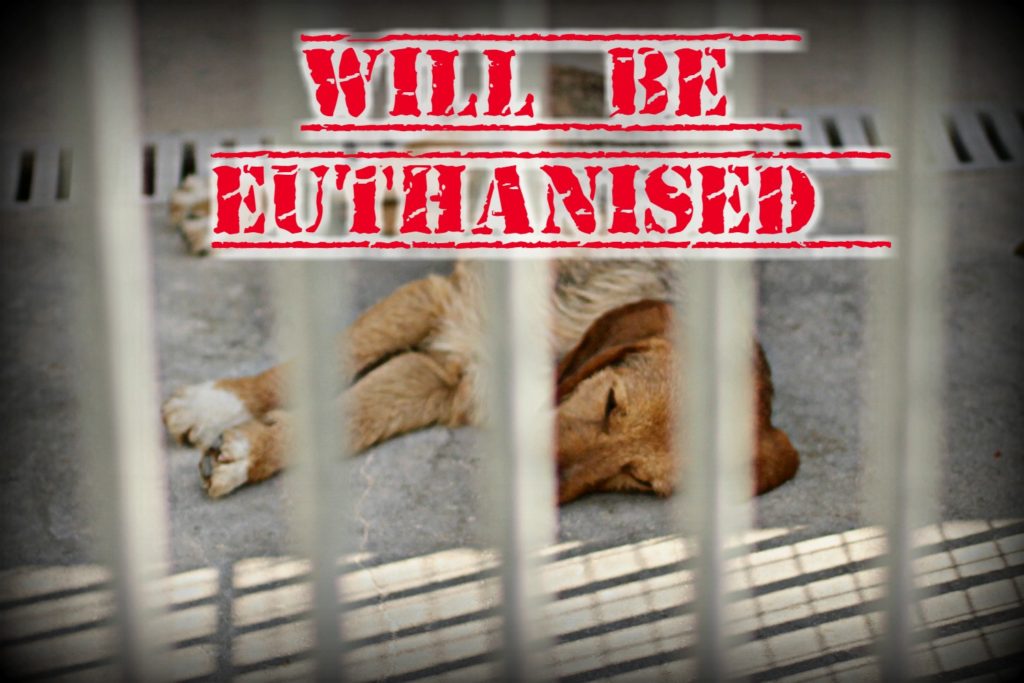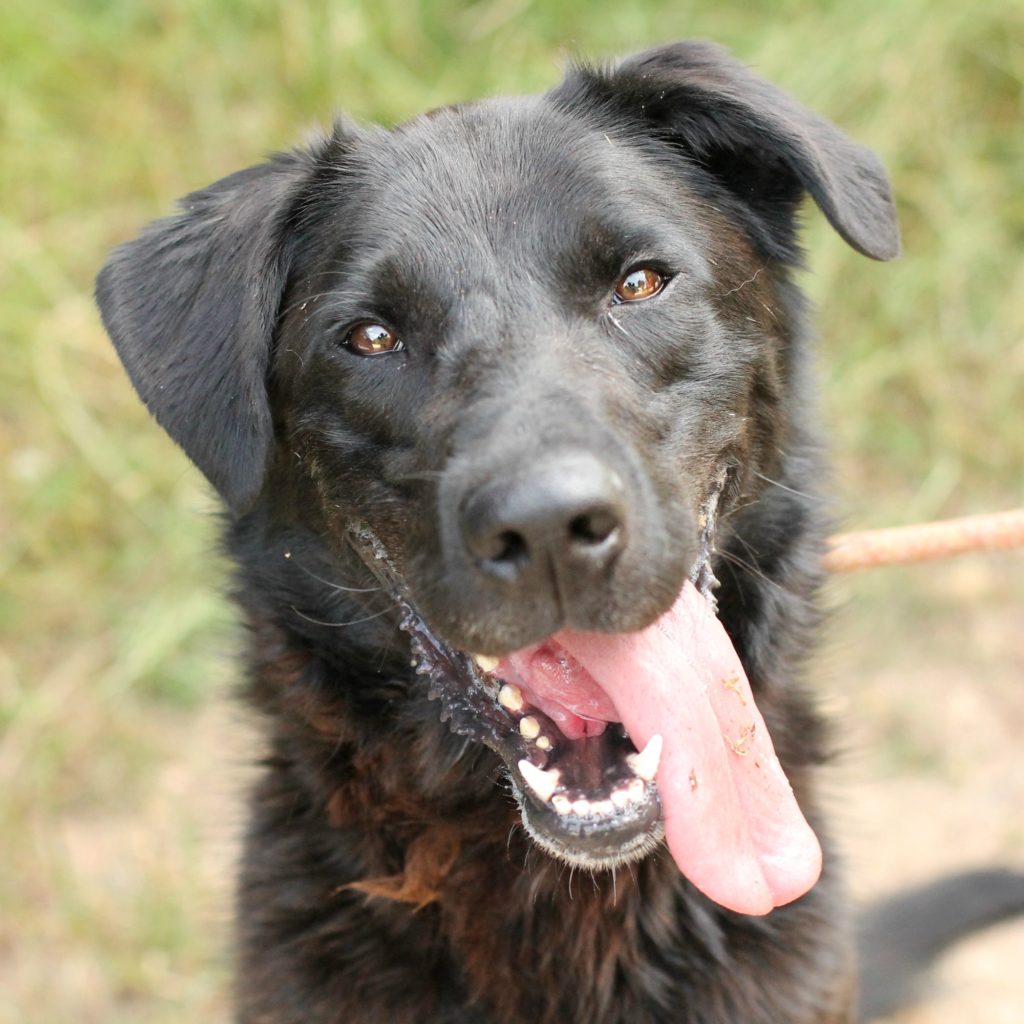Whether we like it or not, social media is a gift to shelters across the world, and it’s up to us to market our animals in a way that not only gets attention and shares, but is also marketing them in an ethical and honest way. Whilst many shelters are really faced with “euth” lists, ethical and honest ones won’t play on your sympathies to find a dog a home. Not even if they are a kill shelter.
There’s an amazing New York Rescue that I follow on Facebook. I have no doubt at all that they have some real issues to face, but they never, ever use emotional manipulation to get an adoption. Yes, they have dogs on “Kill Lists” and they will say that they are dogs with an expiration date which is why they need a foster home or an adoption, but they never, ever post photos of dogs behind bars or dogs on concrete.
I am so totally with them on that.
Sure, you can be honest and say what the situation is. Just because you are faced with a problem doesn’t mean you can’t admit what is likely to happen and say why a dog is urgent.
But no, you should not take advantage of people’s good natures by playing on that situation alone. The consequence is that many good people are taken advantage of and go on to adopt dogs that are unwell, unhealthy or unsuited to the home in which they are placed. I see these all the time from certain European shelters and it makes my heart hurt.
“This dog WILL BE EATEN by the other dogs at the shelter if YOU don’t save her…”
“This dog will be KILLED in this shelter if you don’t give us money…”
“This dog needs emergency adoption or SHE WILL DIE!!!!!!”
You know these appeals. They have LOTS OF CAPITALS AND !!!!!!!!!!!!!!!!!!! They also have Facebook pages with thousands of followers, who all share their posts religiously. Sadly, these adverts rely on making you feel bad rather than relying on finding the best home for a dog. Any home will do.
The adverts are usually grainy, grey photos with sad looking dogs lying on concrete floors with bars behind them, or broken up wooden kennels. You don’t have to look far to find these photos. This is one of my own, by the way. I don’t take many shots like this and I never, ever stick emotive words on the photos because – well, we have different (and very successful) marketing strategies. It would be completely unethical, and it would be a complete lie.
In fact, when making up this photo, I realised that I have only a handful of photos with bars out of the thirty thousand I have taken in the last two years. Really, it was hot, he was sleeping – he was totally chilled out. I took the photo because it was the end of the day and I was seeing how far I could walk down our main block without setting the dogs off barking. But I can quite easily stick a manipulative message on there and pull on your heart-strings until I’ve got a thousand shares.
Good shelters don’t need to share photos like this, even if they face impossible circumstances.
Despite the vast problems we face, the most successful marketing is ethical through and through. For instance, we too have a number of dogs who have never lived in a home. These are hunt dogs that are hard to place in homes. Some of our dogs are incredibly fearful and need very particular homes. It’s not to say they can’t live in a home, or they wouldn’t like to, but I am not ever going to allow them to go to a foreign country to live with an unknown family in an environment that could be incredibly stressful for the dog. That is not to say I wouldn’t allow them to go to a family with whom I’ve had lots of long and serious conversations, but I won’t just package them up, bundle them over the channel and wipe my hands of the whole thing.
Yes, good shelters want homes for their dogs just as much as those who use less ethical marketing strategies.
No, I’m not ever going to lie or manipulate people via photos and appeals just to do it.
That’s why you will never see me share a photo of a dog behind bars. I’m not going to take photos of dogs in places that look like war zones. In fact, I’ll crop out anything that looks remotely scruffy, sad or heart-breaking and deliberately use background blur to avoid showing you bars or concrete floors.
The fact is that some bits of our shelter were pretty unkempt. They are all tarted up and beautiful now, thanks to a great bit of DIYing. But I was never going to take photos that deliberately captured that and then say “well, it’s important people know what it’s like.”
I’m pretty sure most people can imagine what a shelter is like. And you probably imagine many of them as being worse than they are.
Our shelter, for instance, is just like a very, very big boarding kennel. Less shiny, less well-lit and less warm maybe, but then our “guests” aren’t paying 10€ a night to be here. But it’s not any better or any worse than some private kennels I’ve seen where people happily pay to keep their dogs.
If I wanted, I could easily present dogs in a grubby, cold environment and tug on your heartstrings.
But that does both you and the dog a disservice.
So you will get a lot of this instead:
Because the day this little lady can’t look at you and melt your heart is really the day I need to show her on concrete behind bars in the rain.
Yes, there are urgent appeals. There are always urgent appeals. There are dogs who can’t cope in shelters and who need an immediate home. But an honest and ethical shelter will save the heart-rending photos for when it’s really needed.
And do you know what? It’s not dogs like the one above who need me to take sad photos. In fact, it’s the dogs who’ve been in for ages who need them. And they are the kind of dogs who, to be honest, even concrete and euthanasia notices aren’t going to help on appeals very much.
See… Junior is a prime example. He’s just not as cute. No big eyes, despite his happy face, his lovely lolling tongue and doggie smile. He doesn’t look sad or confused. But he looks like a nice dog. A nice, happy dog who is confident and sociable. I really want Junior to find a home, but taking a sad-looking photo of him behind bars isn’t the way to help him find one. In reality, he is just not that kind of a dog. I won’t say that he’s desperate or going to be put to sleep just because he needs a home. He needs the right home, and he depends on our adverts to give him the very best chance of finding one.
So how can you put together an ethical, honest advert that finds homes for your dogs without relying on heart-breaking photographs or emotive text?
The first thing to accept is that there are dogs whose feet aren’t going to touch the floor. You don’t need to market them. They could have the ugliest personalities on the planet but they are going to walk out of the place. If my dog Tilly was at the shelter, she’d be adopted in hours. I don’t need to promote her. To do so would be a waste of my time. Little, cute, blonde, female, pedigree… she’d be gone before the ink was dry on her microchip form. She is a hoardy, guardy, antisocial madam with severe health issues but she needs no help in finding a home. Market if you like, but accept that you will spend hours fending off callers who are pissed off because the dog has already gone.
The second thing to know is that a good photo will definitely draw the eye. But all your photoshop talent is wasted if you don’t have a good write-up. And yes, cute dogs will go first whether they look happy or sad. It’s important to accept that you will have categories of dogs who move more easily than others. That can be based on gender, age, appearance or breed, colour, size or personality. Know where you need to invest your time and don’t worry that the reason you haven’t rehomed a dog is because it doesn’t look cute enough or sad enough.
For us, small, young females under 10kg are going to walk out of the shelter. Our big, middle aged houndy dudes over 25kg are going to be sticking around. If you add in other factors like introverted or nervous natures, a dislike of other males, fixations on cats or rough behaviour around children and you’re talking about factors that will severely hamper a dog’s adoption chances. Not impossible, but harder.
A photo is just a mug-shot, and you can have the best photographers in the world taking pictures of your dog, but if your dog has certain requirements, these are the things you need to be honest about. It is simply no good not to be honest. If you’re honest, you narrow down your target market, but at the same time, you pinpoint the people who tick all the boxes you need them to tick. One happy-looking photo is all you need. People can imagine that happy-looking dog being happy at their house.
The write-up is crucial. Absolutely crucial.
First, you have all the necessaries: male or female, age, size, breed, colour.
For my foster dog Effel, that goes like this: seven-year-old castrated male black-and-tan beauceron.
Then you have all the big factors to help the dog find the right home: whether it gets on with other dogs, and if not, which dogs it does get on with. A good write-up won’t say “dominant” or “submissive” because good dog people know that hierarchies are flexible. They might say “has rough manners at first” or “can be a bit of a bully”, or “doesn’t like dogs who are over-excited at the beginning”. They’ll also say whether they get on with cats maybe. A good advert will also say if the dog would be happy on its own or needs to go to a family who have dogs. Shelters can see this. This afternoon, one dog spent the whole afternoon crying because she didn’t have a friend. Another dog snapped at every single other dog that went past. It’s not a leap to say that a “home on his own would be preferable” or “needs other doggie friends”.
I can then add to Effel’s profile like this: okay with males and female dogs although he would appreciate the companionship of a similar-sized playful female. Great at greetings but needs a home where owners will ensure he doesn’t get over-excited as he gets to know your other dog(s). Effel would hate to be a lonely dog, so a doggie friend is a must.
Sure, there’s a bit of spin. I have put a positive light on the fact he is too rough with smaller dogs or older dogs. Nobody wants a rough dog. Lots of people might want a playful dog to go with their existing playful dog. I’m also not going to say that he has mild separation anxiety which is why he needs a companion. That is something I can explain to people if they’re interested, since it is not so horrible as to be unmanageable, but it would frighten some owners off unnecessarily. I don’t need to say “he’s rough, can’t live with other small animals and he’s got hyper-attachment issues”. Firstly, I don’t know if those things are always true, generally true or only true in my circumstance. Secondly, they’re all things most dogs can live with and I’ve hundreds of videos of him with a variety of other dogs where he isn’t rough and he cried as much when his friends left at an event last week as he has ever cried for me. In fact, that’s a cute and sweet thing to know. I can add that. In my opinion, a home for Effel without dog friends would be a miserable one for him, and I want to tick that box for potential adopters.
Effel is so sad when his friends leave that he sometimes has a little cry. Life is miserable for Effel without friends.
If you’re a potential adopter without other dogs, you’d hopefully skip on by to the next candidate. And if you have other playful dogs, maybe you’re reading on.
I can also add a bit about size, health and other physical and medical details. That’s important too. Honesty counts, especially where medical health is concerned. If it’s not relevant, I leave it out. He has a small scar on his eye from years back. Does it affect him? No. Does it need treatment? No. Will it need treatment? No. Do I need to disclose it? No.
He is a big dog, at 70 cm and 50kg, so if you want a chihuahua to slip in your handbag, you’d better have a giant-sized handbag. Effel likes to stretch out and enjoys space.
If possible, dogs should be tested around children at the shelter, and a statement made about this. It’s not a crime to say a dog needs a home without small humans, especially if that protects both the humans and the dog. Take my foster. He’s met children and he seems fine with them. But…. but he herds the lawnmower and sometimes he tries to herd me. He’s nipped me three times, and I’m sedate at the best of times. Add a flappy child who runs like a maniac and I can’t guarantee he won’t find that super-stimulating. To be safe, I’m going to say “no small children”. Sure, it’s sad and it maybe rules out potential homes, but if I have small children and I am intent on the dog anyway, at least I know what the issue is and I can consider how to work around it. What I know I can prepare for.
You also need to say things about energy levels. People don’t care much about education, and most will be okay with a dog who doesn’t know ‘sit’, but you do need to say if the dog is energetic or highly agile. They also need to know if the dog will need a lot of education, or if the dog tries to escape.
Effel is a good boy in the house, and he never goes off on his own to find himself a pastime, like dismantling your slippers. But he doesn’t have basic commands. Effel won’t be winning obedience medals any time soon. That said, he walks well on the lead. He will need a secure garden at first because his recall isn’t fantastic off-lead. He’s having far too much fun bounding about. Boy, does this dog like to bound. You thought bounding was something that Tiggers did? Bounding is his favourite thing. He doesn’t bound near people and he never jumps on you, but he loves to stretch his legs and he loves to run. For that reason, a home with a large secure garden would be just perfect.
You can see that you don’t need to be harsh about it, but you do need to say what kind of home would suit him.
I always like to add if the dog likes to play, if they seem like they would enjoy obedience or agility classes, cani-cross or swimming. We just rehomed a husky named Guapo who just loves the water. Paddling is about his favourite thing to do. Why wouldn’t I share that?
After this, I use basic statements about whether they are an introverted or extroverted dog. That’s easy to do. Do they move towards new things or away? Are they social? Do they come for affection? Are they demanding for affection?
For my super-tough-to-rehome dogs, I will also use the University of Pennsylvania’s C-BARQ questionnaire. That told me very little I couldn’t work out, but for Effel, it allowed me to say that he has mild attachment issues and needs an eye on his behaviour around dogs that he is becoming more familiar with. For my old mate Hagrid at the shelter, it allowed me to say that he probably needs a home on his own away from other dogs. Nothing that 14 months of shelter living won’t tell you.
And I also use the Monash Canine Personality Questionnaire to help me describe the dog’s temperament. It’s always a tough call to describe a dog’s personality, but knowing that dog feelings pass quickly and that what you have from day to day is more likely to be a reliable guide to personality, this can help you. I’m not going to say things I can’t say for sure, so if I think I’m just embellishing, I leave it out. This questionnaire rates the “Big Five” personality types, from extraversion, motivation, training focus, amicability and training focus. With adjectives like friendliness, nervousness, attentiveness, independence, intelligence and fearfulness, it helps draw up a more complete profile of dogs for me to share with their photos. It also helps me make decisions about the kind of home the dog will need. A nervous dog will not fare well in a home with many family members and lots of comings and goings. Similarly, an intelligent and independent dog is going to make her own entertainment if she goes to a home on her own with owners who work eleven hours a day.
Although Effel will need a home where owners are more often present than they are not, he is happy to accompany you wherever you go. Sure, he doesn’t look like your typical pavement café kind of dog, but he wants nothing more than to be by your side. He is attentive, intelligent and alert. To leave a dog like this to his own devices for hours on end will not make him happy, as being with you is what makes him happy. Effel is reserved at first but forms quick bonds with both humans and other dogs.
And that’s how the MCPQ-R helps me write adoption profiles.
Some people, by the way, are worried about the effect of shelters on personality and canine reactions, whether these descriptions are true. Both the C-BARQ and the MCPQ-R have been tested in different situations and are reliable tools. Early research shows that most dogs adapt quite quickly to shelter life: what you see here isn’t going to be massively different than in the home on the whole. The exception are nervous or shy dogs who may build up confidence. Some shepherd breeds also seem to find kennel living stressful. That is also true of some uncastrated males who may find all the scents to be totally overwhelming. These dogs are the exception though, rather than the rule. You will of course notice differences in energy levels, but it is rare for a high-energy shelter dog to become a low-energy house dog, or the other way around.
So that’s it…. the way to write adoption profiles that are individual, interesting, honest and ethical! You don’t need to rely on WILL BE EUTHANISED!!!!!!!!!!!!!!!!!!!!! or BEING ATTACKED BY OTHER DOGS!!!!!!!!!!!!!!!!!!!!!!! Neither do you need bleak and depressing photographs. When it comes to adoption, we should be encouraging people to think with their rational side, their heads, not their hearts. This way, there are fewer returns and fewer people who have trouble with the dog that they have.
I truly believe there are homes for every dog. It is this belief that has driven the adoption of many of our “unadoptable” dogs and placed them in homes where they have gone on to be rehomed without comeback calls. In fact, one of our “tough to rehome” guys had gone on adoption and I’d not heard anything for 48 hours. When she called on the Sunday, I was convinced it was going to be a return. No. After five years of shelter life, over three-quarters of his life on concrete, he had settled in without a single hiccup. Sure, he was a great dog, but in any other home, he could have been a real problem.
Finding the right home depends on how accurately shelters market their dogs. Pepper that with a bit of humour, a bit of fun, a lot of the dog’s character and a few photos that show the dog’s nature, and you have a winning combination that takes the pressure of you for lengthy pre-adoption screening and also provides you with a template for the questions you ask at adoption interviews.
And there you have it: the winning formulas for finding your dogs their home for life.





